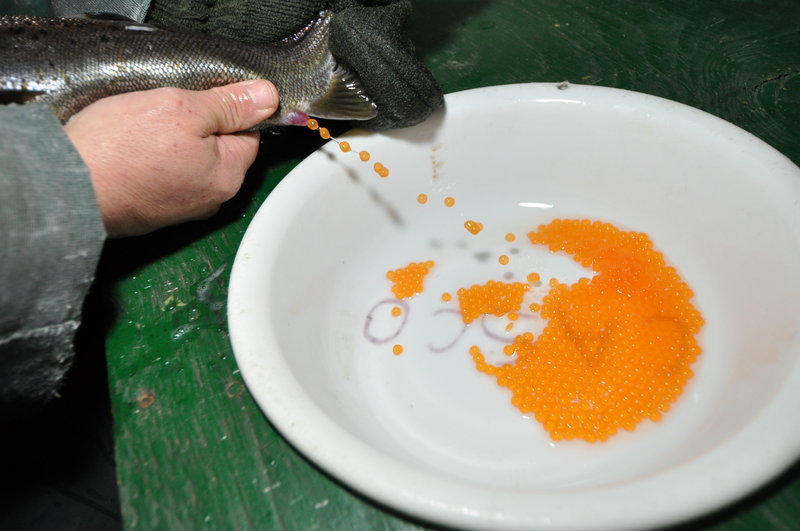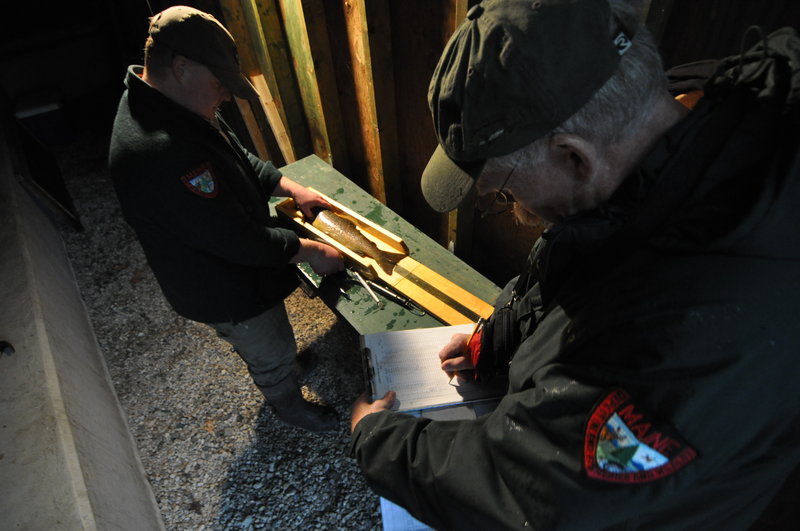Finning in 40-degree water in a sheltered, concrete raceway certainly doesn’t evoke images of gravity-defying salmon, vaulting skyward as they leapfrog from pool to pool in search of their ancestral spawning grounds.
Still, landlocked salmon are here in the Jordan River in Raymond to spawn, just like their Atlantic brethren who populate rivers with more recognizable names, such as the Miramachi or Bonaventure.
The 2-mile journey upstream from Sebago Lake fails to inspire the orations often associated with an Atlantic salmon’s odyssey. But to anglers, the trip up the Jordan River is vitally important to the health of Maine’s landlocked salmon fishery. For this is one of two places in the state where salmon are collected and “stripped” of their eggs and milt for use in stocking landlocked salmon around the state.
Landlocked salmon are native to Maine, but originally, they were found only in four watersheds in the state: the St. Croix, which includes Grand Lake Stream in Washington County; the Union River, including Green Lake in Hancock County; the Penobscot, which includes Sebec Lake in Piscataquis County; and of course, the Presumpscot, including Sebago Lake in Cumberland County.
Anglers flock to Sebago Lake each year for a chance to land a landlocked salmon, but what most anglers don’t know is that about the half the landlocked salmon stocked throughout the state come from Sebago.
Sebago Lake landlocked salmon are world-renowned. For many years, Sebago was home to the world record landlocked salmon, a 22-pound, 8-ounce monster. It was Sebago Lake smolts that were used to populate landlocked salmon in the Patagonia region of Argentina.
Landlocked salmon are the same species, salmo salar, as Atlantic salmon. The urge to spawn in these fish is extremely strong, and they will go to great lengths to do so.
However, in most lakes and ponds in Maine, there isn’t suitable spawning habitat to sustain these fisheries. While a premium is paid to secure and protect habitat such as the Crooked River in the Sebago Lake watershed, factors such as dams and development limit the amount of spawning habitat to sustain many cold-water fisheries.
That’s why each year in November, a crew of Inland Fisheries and Wildlife personnel gather in Raymond to assist these salmon in spawning.
Like so many other salmon that migrate upriver, these landlocked salmon are blocked by a dam. However, an installed fishway leads the salmon to concrete pens, where they stay until the salmon are “ripe” for spawning.
Once the fish are ripe, a team of state fish culturists and biologists assist these salmon in the spawning.
The salmon are first anesthetized, using a natural mint oil diluted in the water. Then one of the team strips female salmon’s eggs by massaging and manipulating a fish’s belly, dropping her golden orange eggs into a large plastic bowl. A male salmon is stripped of its bright, white milt into the same bowl.
The eggs and milk are mixed thoroughly in hopes of fertilizing all the eggs, and then a portion of the eggs, not all of them, are scooped out and secured for their journey to the hatchery. The salmon are weighed and measured before they are released back into the river.
Culturists take only a portion of the pair’s fertilized eggs, then take a portion of the next pair’s, and so on, to maintain as wide a genetic diversity as possible. In some years, over 100 salmon will be stripped. This year’s count was in the 70s. The eggs are also examined by the state’s fish pathologist to check for diseases.
Once these fertilized eggs get to the hatchery, they are placed in egg trays, where the eggs will hatch out into fry later this winter. As they grow, they will be moved to larger tanks and eventually into other hatcheries throughout the state before they are released into the wild, starting at about 18 months from the time the adults spawned.
In the end, those migrating salmon that traveled 2 miles from the depths of Sebago Lake will have offspring that will populate waterways throughout the state.
Mark Latti is a former public information officer for the Maine Department of Inland Fisheries and Wildlife and a Registered Maine Guide. He can be reached at:
mlatti@gmail.com
Copy the Story Link
Send questions/comments to the editors.




Success. Please wait for the page to reload. If the page does not reload within 5 seconds, please refresh the page.
Enter your email and password to access comments.
Hi, to comment on stories you must . This profile is in addition to your subscription and website login.
Already have a commenting profile? .
Invalid username/password.
Please check your email to confirm and complete your registration.
Only subscribers are eligible to post comments. Please subscribe or login first for digital access. Here’s why.
Use the form below to reset your password. When you've submitted your account email, we will send an email with a reset code.